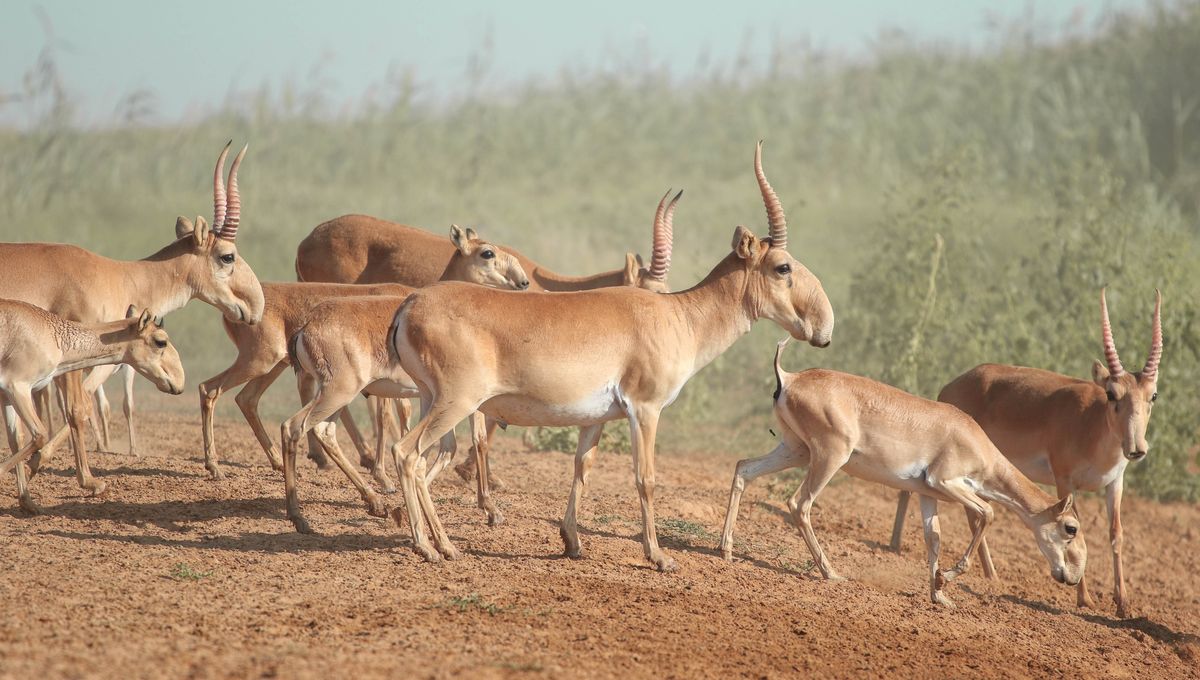
In May 2015, a wave of death swept over rural Kazakhstan. In the space of just a few weeks, some 200,000 saiga antelopes mysteriously dropped dead. It took years of scientific snooping to find the culprit, but researchers eventually weeded out a clear chain of events that led to the mass die-off.
Saiga antelopes (Saiga tatarica tatarica) are native to a small pocket of the Eurasian Steppe in Kazakhstan and parts of southern Russia. Their most distinguishing feature is their oversized, humped noses that make them look like a background character in Star Wars. You’re not wrong if you think they look like a throwback to a prehistoric time; these creatures walked alongside woolly rhinos and mammoths during the Ice Age.
They have lived in their current form for thousands upon thousands of years, but they had a very close call in May 2015. The mass die-off, one of the biggest of its kind ever recorded, wiped out 80 percent of the local population and more than 60 percent of the global population of the species.
The situation was described as “unprecedented” as population crashes of this magnitude are extremely rare among large mammals. However, they aren’t entirely unheard of in antelope species. In fact, the saiga themselves had experienced multiple die-offs in the 1980s, though none on this scale.
Shocking images showed vast grassy plains in Kazakhstan that had become littered with thousands of dead antelopes, seemingly struck down without a moment’s notice.
“It’s shaping up to be a complete catastrophe,” EJ Milner-Gulland, a Professor of Biodiversity at the University of Oxford who co-founded the Saiga Conservation Alliance, reportedly said at the time.
As the bodies piled higher, scientists were struggling to reach an explanation. Multiple theories went around, from toxic fuels used by Russian rockets to unseasonably warm temperatures in the region.
Ultimately, it was found that a few different factors were involved in the mass mortality event. The bacterium Pasteurella multocida was pinpointed as the prime cause of the saiga deaths. Weirdly, though, the bacteria had been living harmlessly in the animals’ tonsils up to this point. So what changed?
Further investigation showed that the region was struck by an unusual bout of warm, humid in the deaths before the deaths. This provided the ideal circumstances for the opportunistic bug to thrive and infect the antelopes’ bloodstream, leading to hemorrhagic septicemia (a particularly nasty form of blood poisoning).
Yet another mass mortality event hit the saiga in 2017 and 2018, this time in Mongolia. Thankfully, insights gained from the 2015 crisis and subsequent research equipped experts and conservationists with better tools to respond. It also helped to explain these previous mass deaths of saiga that occurred in the 1980s.
“MMEs [mass-mortality events] are a major threat for the saiga antelope and can wipe out many years of conservation work and saiga population growth in just a few days. Therefore, understanding these MMEs, what triggers them and what can be done to combat them is extremely important to develop effective saiga conservation strategies,” Steffen Zuther, Project manager for Kazakhstan at the Frankfurt Zoological Society/Association for the Conservation of Biodiversity of Kazakhstan, said in a statement.
“The triggering of such MMEs in saiga through weather conditions shows that not much can be done to prevent them occurring, and therefore how important it is to maintain saiga populations of sufficient size for the species to survive such catastrophes,” added Zuther.
Today, there’s renewed hope for the species. In 2024, the Earthshot Prize recognized a major ecosystem restoration initiative that has played a key role in the saiga’s recovery. Over the past two decades, more than 75 million hectares (over 185 million acres) of grassland, wetland, and desert have been restored in Kazakhstan, enabling the wild saiga population to surge from just 40,000 to 2.8 million.
The population is booming so much, Kazakhstan said in May 2025 that it will reauthorize the hunting of saiga antelopes. A spokesperson for the Kazakh ecology ministry told AFP this week that “according to scientific research, it is possible to eliminate up to 20 percent of the total population without harming the species.”
Source Link: In 2015, Over 200,000 Saiga Mysteriously Died In An Unprecedented Event: What Happened?